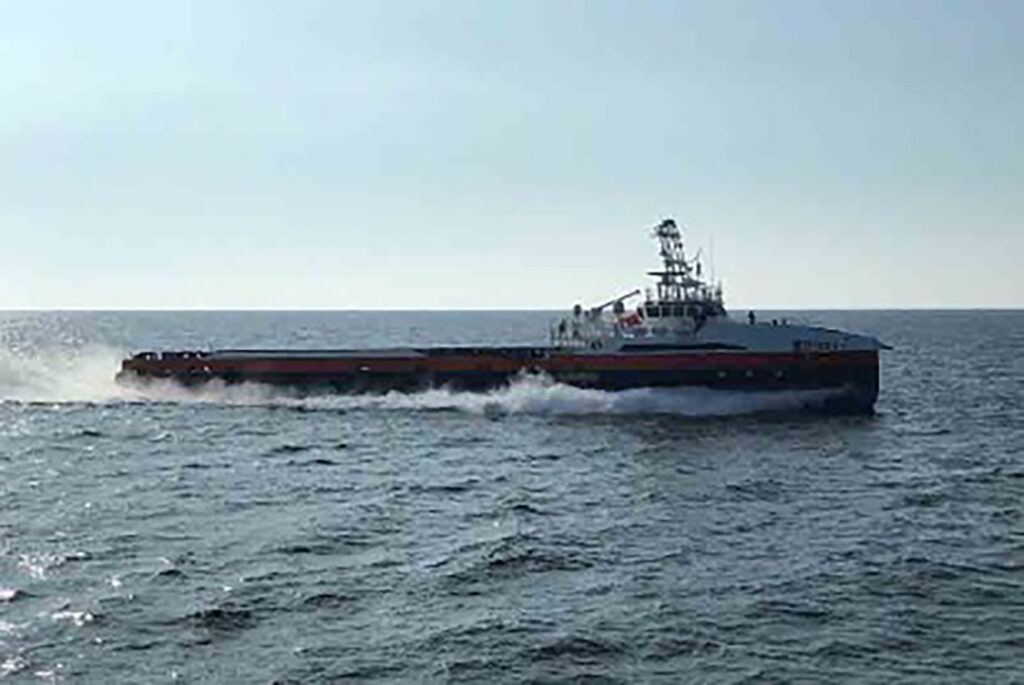THE WATCH STAFF
The Pentagon has taken another step toward integrating autonomous weapons into its fighting forces with the creation of a Navy division to help develop drone surface ships.
At the center of the Unmanned Surface Vessel Division 1 (USV DIV 1) is a long, skinny trimaran developed by the U.S. Department of Defense (DOD) that can lie in wait weeks at a time for an adversary’s stealthy diesel submarine to surface. This prototype, called Sea Hunter, and a second copy called Sea Hawk, join two other autonomous vessels — converted civilian offshore-supply ships — that now are assigned to California-based USV DIV 1.
The division will focus on experimentation and helping to work unmanned vessels into the Navy’s surface force, including development of training for operation and maintenance.
“USV DIV 1 will be a catalyst for innovation as we employ unmanned surface capabilities in the Pacific Fleet,” Vice Adm. Roy Kitchener, commander of the U.S. Pacific Fleet’s Surface Force, said in a ceremony May 13, 2022. “The implementation of unmanned systems will increase decision speed and lethality to enhance our warfighting advantage.”
The People’s Republic of China has the world’s largest navy by ship count, at 355, and the U.S. is working to counter this by amplifying its manned ship and aircraft fleet with uncrewed and lightly crewed platforms capable of gathering information and firing weapons, Chief of Naval Operations Adm. Mike Gilday told reporters in February 2022, according to USNI News.
Toward this end, the Navy aims to develop three sizes of large, unmanned surface vessels while shifting the service to a more distributed fleet architecture, according to a report from the Congressional Research Service. The goal is a smaller proportion of larger ships such as large-deck aircraft carriers, cruisers and destroyers, and a larger proportion of smaller ships such as frigates and corvettes. Unmanned surface vessels would constitute a third tier of ships. The first five extra-large unmanned surface vessels are being built by Boeing and are roughly the size of a subway car. The Navy would use them, in part, to covertly deploy anti-submarine mines.
Unmanned systems present a number of advantages for the military, the Defense Department said in its report “Unmanned Systems Roadmap: 2007-2032.” This is especially true in missions described as “dull, dirty, or dangerous” — long-duration sorties, for example, potential exposure to radioactive materials or disposal of explosive ordnance. There are considerable cost savings, as well, when the need to sustain human crews is removed.
At 132 feet long, the trimaran Sea Hunter is the size of a medium unmanned vessel. The ship can accommodate various payloads and likely will be used at first for intelligence, surveillance and reconnaissance, as well as electronic warfare. With a composite hull, foam core and outrigger floats for stability, the Sea Hunter, pictured, cost just U.S. $18 million to build and some U.S. $15,000 a day to operate, according to a 2018 video from the Defense Advanced Research Projects Agency. That’s far less than crewed ships performing some of the same tasks. The Sea Hunter can travel 10,000 nautical miles and remain at sea for months at a time. Among its capabilities is towing a TALONS parasail, designed for uses that include communications relay.
The two converted offshore-supply ships assigned to USV DIV 1, Nomad and Ranger, have successfully completed separate long-range autonomous tests at sea, sailing from the Gulf of Mexico to the West Coast. During a journey of 4,421 nautical miles, Nomad operated autonomously 98 percent of the time, the Defense Department said, with manual control required only to transit the Panama Canal and to dock in San Diego. Before they were assigned to USV DIV 1, these ships underwent trials as part of Ghost Fleet Overlord, a partnership between the Navy and the Defense Department’s Strategic Capabilities Office.
USV DIV 1 expects to receive three additional unmanned surface vessels in the next three years, two from Ghost Fleet Overlord and a third that’s being built from the ground up as a prototype, Capt. Jeff Heames, outgoing commander of Surface Development Squadron 1, told reporters in May 2022, according to USNI News. “We’re growing, so that means more opportunities to take these things to sea, more opportunities to learn about how we need to operate with them with our manned Navy,” Heames said. “And now that we have a USV division command entirely focused on USVs, we think that opportunity is going to grow for us to learn more about how USVs are going to fit into the manned fleet.”
USV DIV 1 is part of San Diego-based Surface Development Squadron 1, established in May 2019. The squadron is responsible for medium and large unmanned surface vessels as well as the Zumwalt class of stealth destroyers — the Zumwalt, the Michael Monsoor and the future Lyndon B Johnson. USV DIV 1 is expected to have 175 Sailors by the end of 2023.
The Navy stands up the new division in time for the Rim of the Pacific exercise (RIMPAC), June 29 through Aug. 4 in the Hawaiian Islands and Southern California. The biennial RIMPAC, begun in 1971, is the world’s largest international maritime exercise, now involving 26 nations, 38 surface ships, four submarines, nine national land forces, more than 170 aircraft and approximately 25,000 personnel. The vessels of USV DIV 1 will take part.
“All four ships will be dispersed,” Cmdr. Jeremiah Daley, who heads the new division, told reporters, according to USNI News. “We’ll be working with different task force commanders during all three phases of the Rim of the Pacific exercise, both from a command-and-control standpoint and also exercising our capabilities from a payload standpoint. Part of our charter is figuring how we integrate with a manned force.”
IMAGE CREDIT: STRATEGIC CAPABILITIES OFFICE

